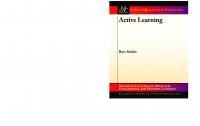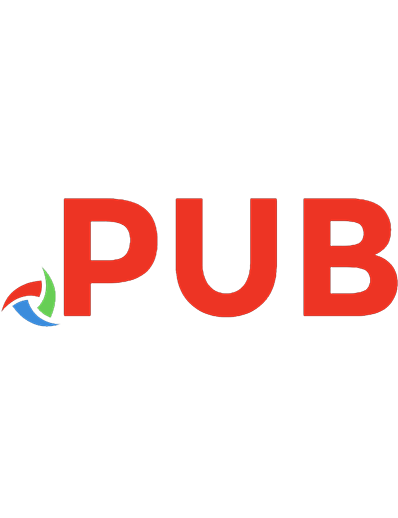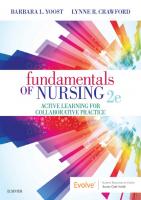Problem-based learning and pedagogies of play: Active approaches towards Self-Directed Learning [1 ed.] 9781779952783, 9781779952790, 9781779952806
This academic book focuses on scholarly research contextualising innovative learning and knowledge construction by apply
132 63 7MB
English Pages 276 [320] Year 2023
![Problem-based learning and pedagogies of play: Active approaches towards Self-Directed Learning [1 ed.]
9781779952783, 9781779952790, 9781779952806](https://dokumen.pub/img/200x200/problem-based-learning-and-pedagogies-of-play-active-approaches-towards-self-directed-learning-1nbsped-9781779952783-9781779952790-9781779952806.jpg)
- Author / Uploaded
- Marietjie Havenga
- Jako Olivier
- Byron J Bunt (Editors)
- Categories
- Education
- Commentary
- https://books.aosis.co.za/index.php/ob/catalog/series/sdl
Table of contents :
Front Cover
Contents
Abbreviations and acronyms, boxes, figures and tables appearing in the text and notes
List of abbreviations and acronyms
List of boxes
List of figures
List of tables
Notes on contributors
Foreword
Preface
Chapter 1 Problem-based learning: A 21st-century teaching and learning strategy
Abstract
Introduction
Historical development of problem-based learning
Definition of problem-based learning
Key features of problem-based learning
The problem-based learning process
Problem-based learning formats
Problem-based learning and self-directed learning
The role of facilitators and students in problem-based learning tutorials
Scaffolds in problem-based learning environments
Assessment in problem-based learning
Different types of problem-based learning problems
The design of problems
Advantages and challenges of the implementation of problem-based learning
Problem-based learning and pedagogies of play
Conclusion
Chapter 2 Pedagogy of play: A framework for self-directed learning
Abstract
Introduction
Pedagogy of play
Theoretical foundations and development
Characteristics of playful learning
Methodology
Theories linked to pedagogies of play
Self-determination
Social constructivism
Self-regulated learning
Self-directed learning
Problem-based learning
Cooperative learning
Pedagogy of play strategies
Puppetry
Improving communication output
Fostering a positive classroom environment
Creating a creative space
Fostering cooperation and group integration
Influencing learner attitudes
Drama and role-play
Interest
Affect
Structure
Game-based learning and gamification
Game-based learning factors promoting self-directed learning
Learning analytics as a metacognitive tool
Gradual release of new information over time
A place where people may test out new ideas without fear of repercussions
Defamiliarisation mechanics
Scaffolded learning: An in-game companion
LEGO®
Educational robotics
Conclusion
Chapter 3 Designing interactive pedagogies of play through metaliteracy
Abstract
Introduction
Creative pedagogy of play
Problem-based learning
Multimodality
Metaliteracy
Learning domains
Affective
Goal 4: Adapt to new learning situations while being flexible about varied learning approaches
Goal 4: Adapt to and understand new technologies and the impact they have on learning
Goal 3: See oneself as a producer as well as a consumer of information
Cognitive
Goal 3: Recognise that learners are also teachers and teach what you know or learn in collaborative settings
Goal 4: Recognise that critical thinking depends upon knowledge of a subject and actively pursue deeper understanding through inquiry and research
Goal 4: Effectively communicate and collaborate in shared spaces to learn from multiple perspectives
Behavioural
Metacognitive
Learner roles and characteristics
Applying holistic strategies for multimodal pedagogies of play
Play-infused activities for first-year students
Collaboration and problem-solving
Locked-box game: BreakoutEDU
Collaborative creation of an online whiteboard
Play-based activities in upper-level courses
Course: ‘Digital Storytelling’
Course: ‘Ethics of Digital Art and Design’
Conclusion
Chapter 4 Joyful learning: Advocating for self-directed learning through authentic, playful problem-based learning
Abstract
Introduction
Contextualised learning environments
Learning with, from and through others
Learning with others
Learning through and from others
Individualised learning: Learning that is for me and about me
Creating a constructive classroom atmosphere for learner-centred learning
The importance of a constructive and encouraging classroom atmosphere
A sense of belonging as a precondition for ownership of learning
What is play-based learning, and why is it important?
Defining play-based learning
Striving toward fostering 21st-century skills
Creating safe, playful spaces
Authentic, meaningful learning through play
Playful problem-based learning supports self-directed learning
Being empowered
Being motivated
Developing agency
Developing self-actualisation
Developing creativity and problem-solving skills through hard fun
Playful problem-based learning promotes well-being
A conceptual framework for self-directed playful problem-based learning to promote joyful learning
Recommendations for transformed teaching and learning practices
Conclusion
Chapter 5 Mathematics education students’ development of computational thinking through game-based tasks
Abstract
Introduction
Context and related work
Constructionist view
Development of computational thinking
Block-based tools to develop computational thinking
Scratch programming environment and repository
BBC micro:bit
Teaching–learning strategies to promote computational thinking
Game-based learning
Computational thinking and self-directed learning
Research methodology
Participants and research ethics
Context and student activities
Activity 1: Mathematics and computational thinking
Coding tasks using Scratch: Task A
Coding tasks using Scratch: Task B
Activities 3–5: MS Teams meeting, MS PowerPoint presentation and reflections
Assessment of computational thinking tasks
Data collection and analysis
Findings
Discussion
Recommendations and limitations
Conclusion
Acknowledgements
Chapter 6 Introduction to computational thinking in geometry through a LOGO problem-based learning experience with high school learners in Morocco
Abstract
Introduction
Background and issues
Learners and mathematics
Choice of language
Coding by LOGO: Learning in a fun way and initiating computational thinking through problem-based learning
Computational thinking: Conceptual framework
Design
Attitudes and skills targeted
Methodology and method
Research design and methodology
Sample
Approach
Pre-test
Coding knowledge
Post-test
Post-test and questionnaire criteria
Evaluation criterion
Attitude and perception criterion
Conducting the experiment
Processing of experimental data
Component 1: Assessment by a knowledge test
Component 2: Satisfaction questionnaire
Results
Result of student assessment (Component 1)
Result of the questionnaire (Component 2)
Discussion
Conclusion
Chapter 7 A gamification approach to linear equations through creating and solving puzzles in a collaborative learning environment
Abstract
Introduction
Literature review
Mathematics and linear equations
Self-directed learning
Open educational resources
Gamification
Elements of gamification
Using gamification to improve learners’ motivation and academic performance
Gamification and self-directed learning
Methodology
Research design, data collection and analysis
The learning context
Coins
Ages
Number
How the interactives are to be used by the learners
Design aspects of the interactives
Manipulatives and multiple representations
Scaffolding – externalisation of memory
Self-directedness
Gamification via the platform
Examples of use: Gamification of linear equations
Example 1
Example 2
Discussion
Conclusion
Acknowledgements
Chapter 8 LEGO®-ing in the development of teacher identity
Abstract
Introduction
Problem statement
The apprenticeship of observation
Self-directed learning
Problem-based learning
Play-based learning
LEGO® as an alternative spatial tool to explore identity
Empirical research
Research paradigm
Research design
Methodology
Sampling and data analysis
Student activities
Discussion of findings
Perceptions of attributes and skills teachers need
Perceptions of important role-players in their journeys of becoming teachers
Relationships
Attributes and skills inside the educational context
Relationships with learners
Relationships with former teachers
Relationships with the university and with the faculty
Attributes and skills outside the educational context
Resources
Digital resources
Non-digital resources
Content knowledge
Reflection on problem-based learning and play-based learning for student engagement and the promotion of self-directed learning skills
Conclusion
Chapter 9 Impact of drama-based pedagogy on self-directed learning skills and motivation in Grade 12 English Home Language learners
Abstract
Introduction
Literature study as part of language curricula
Drama-based pedagogy
Self-directed learning
Research design
Methodology
Sampling and data analysis
Discussion of findings
Learners’ level of engagement with drama activities through classroom observations
Focus-group interviews: Pre-exposure to drama-based activities
Participants’ perceptions of English Home Language and its relevance to their lives
Poetry teaching and learning in the English Home Language subject
Focus-group interviews: Post-exposure to drama-based activities
The impact of drama-based pedagogy on learners’ self-directed learning skills through the analysis of learners’ pre- and post- self-rating scale of self-directed learning questionnaires following their engagement with drama-based activities
Reflection on play-based learning for student engagement and the promotion of self-directed learning skills
Limitations
Conclusion
Chapter 10 Educational robotics for playful problem-based learning: Using cultural-historical activity theory as a research lens
Abstract
Introduction
Theoretical overview
Educational robotics
Educational robotics and playful problem-based learning
Professional development and self-directed learning
Cultural-historical activity theory
Third-generation cultural-historical activity theory
Playful problem-based learning intervention using educational robotics
Participants
Contextualised robot activities
Findings
Authentic playful problem-based experiences
Active student collaboration and communication
Students’ reflections on robot activities
Essential skill development for the future
Discussion
Reflective points, recommendations and limitations
Conclusion
References
Index







![Active Learning Spaces : New Directions for Teaching and Learning, Number 137 [1 ed.]
9781118870280, 9781118870112](https://dokumen.pub/img/200x200/active-learning-spaces-new-directions-for-teaching-and-learning-number-137-1nbsped-9781118870280-9781118870112.jpg)

